

Apple MacBook Air M2 review – is it really that «magical»?
Apple’s 2022 MacBook Air comes with the new M2 processor and a larger, brighter display compared with the M1 of the previous generation. Read on to find out what else is different, what’s actually worse, how well the laptop performs in practice and what an Apple sceptic makes of it.
From the outside alone, the new MacBook Air M2 appeals to me straight away. But it’s yet to be seen if I’m just as impressed when I’m using it for work and putting the purely passive cooling design and ARM architecture through its paces. After half a decade of Windows and Linux, I’m finding my way back to the apple with a bite out of it. The last time I’d encountered it professionally was five years ago. But outside of work, I’ve never owned anything from Apple, a brand that’s particularly popular in Switzerland.
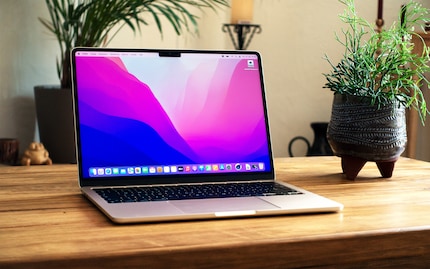
For almost five years since I’ve been at digitec, I’ve been eyeing up Apple notebooks. However, I always ended up sending them to colleagues who could muster more enthusiasm for them. Plot twist: they’re all on their summer holidays right now.
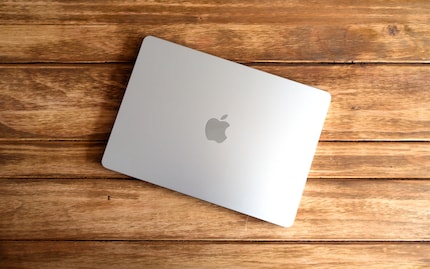
Before I switch from Windows to macOS, I take a deep breath and put any prejudices aside. Then I head off into a parallel universe, where practically everything works the same, but always a bit differently.
Where’s the delete button again?
The test device and its specs
For this review, Apple provided me with the entry-level version with Swiss keyboard, 8 gigabytes of working memory, 8 processor cores, 8 graphics cores and 256 gigabytes of SSD. I used it as my primary work tool for about two weeks and gave it a proper road test. The colour it comes in is called Starlight, which is a silver tone with a gold shimmer. To help put things into perspective and have comparative values at hand, I also used our warehouse to get hold of the entry-level version of the predecessor with M1 chip.
CH

DE
Specifications for the test device at a glance:
| Processor (SoC): | Apple M2 chip (4 performance and 4 efficiency cores, 8 GPU cores) |
|---|---|
| RAM: | 8 GB |
| Data storage: | 256 GB SSD |
| Display: | 13.6 IPS display (Liquid Retina Display), 2560 × 1664 pixels (224 PPI), aspect ratio of 16:10, 500 nits, glossy) |
| Ports: | 2 × Thunderbolt 3 (one external monitor in selectable form), 3.5 mm jack, MagSafe charging port |
| Audio: | 4 hidden built-in speakers (stereo, support for Spatial Audio), three-mic array with directional beam forming |
| Camera: | 1080p front camera (FaceTime HD camera) |
| WiFi, Bluetooth | Wi-Fi 6, Bluetooth 5.0 |
| Sensors | Ambient light sensor, fingerprint sensor (Touch ID) |
| Operating system | macOS (Monterey) |
| Battery capacity | 52.6-watt‑hour lithium‑polymer battery |
| Power adapter | 30 watts |
| Dimensions | 30.41 × 21.5 × 1.13 cm, 1.24 kg |
To see all the MacBook Airs with M2 processor, click here. You can get the laptop with either eight or ten graphics cores. You can choose between 8, 16 and 24 gigabytes of RAM, and the SSD comes with 256, 512, 1000 or 2000 gigabytes. In terms of colours, there’s Midnight, Space Gray, Silver and Starlight. Some MacBook Air reviewers reported issues with the Midnight version being susceptible to scratches.
Design and ports
If you take an unbiased approach, the new MacBook Air M2 actually looks damn good. Just as with Microsoft’s Surface laptops, the M2 design seems timeless and uniform. Now it’s bravely showing how bulky it can be. The curved design on the bottom of the base, which gives a thinner look on the M1, has made way for industrial design.
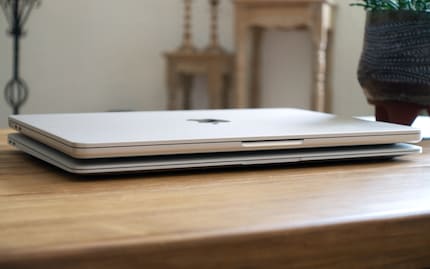
When turning the case over, only half as many screws are visible as before. There are also new rubber pads integrated into the case design. They’re somewhat enveloped by the shimmering aluminium.
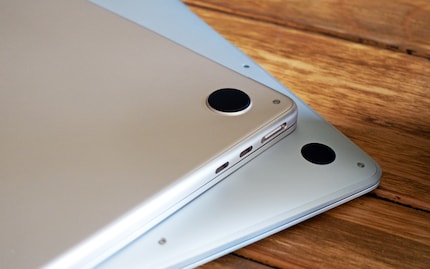
Things get interesting when it comes to ports. You don’t charge up via USB-C any more. Instead, it’s with the new version of MagSafe. That’s a magnetic connector, attaching better than Microsoft’s Surface competition and possessing integrated multicolour LEDs. It allows charging for the new Air M2 without occupying one of the Thunderbolt 3 ports (USB-C). That being said, you can still charge it using both Thunderbolt slots if needed. It’s a shame that Apple only lets you connect an external monitor – but still, it has up to 6K resolution at 60 Hertz. Last but not least, there’s a 3.5 mm jack plug on the right-hand side.
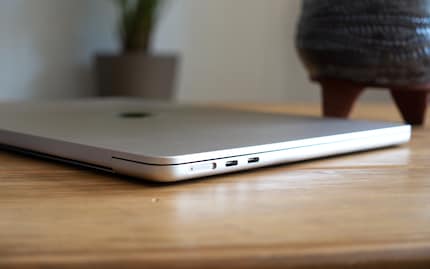
When comparing the new charging cable, I immediately noticed that not only is the MagSafe connector back, but the cable looks different as well. It now has a textile covering and feels much better. The predecessor came with a rubber-coated cable that feels a bit sticky. No more – the cable hardly curls at all thanks to its textile sheathing.
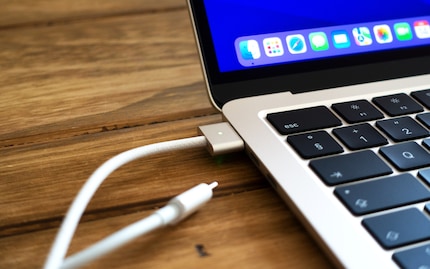
When you open the screen, a complete makeover eagerly awaits you. The IPS display now has a resolution of 2560 × 1664 pixels (224 ppi), is brighter (up to 500 nits), has been pulled further to the edge – sideways and across the top I measure about six millimetres. It also now has a notch, and the display mask is rounded at the upper corners. The scaling of macOS Monterey 12.4 is adapted to the notch, making the entire surface appear more filled out. There are slightly fewer apps in the dock.
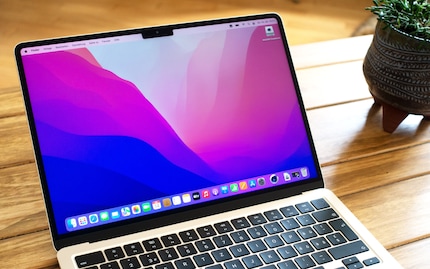
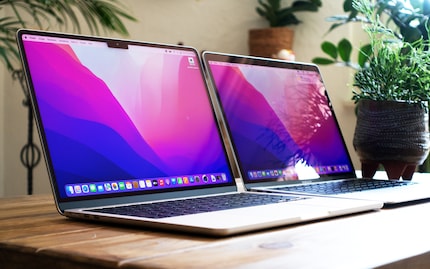
Looking at the keyboard and trackpad, these are the adjustments that stand out. The speakers next to the keyboard seen on the M1 have disappeared. Now music plays invisibly. Apple has also adjusted its top row of buttons to the size of all others, including Touch ID.

The trackpad, on the other hand, is almost the same – 12.8 × 8 centimetres versus 12 × 8.2 centimetres.
Liquid Retina Display – what’s the story behind the great name?
The fact that Apple advertises the MacBook Air panel as a «Liquid Retina Display» makes it sound good. But how good is it really?
I can only really give two thirds of an answer. The first part of the answer comes from my subjective overview of the resolution and colour reproduction. I particularly like films with True Tone, which is activated as standard. Conversely, when I’m working, I prefer to deactivate the option otherwise white surfaces get a slightly yellow tinge. The image looks high-contrast and the colours are rich. But how accurate does the display represent the common colour spaces when I measure it?
I usually measure the colour space coverage of sRGB, Adobe RGB and DCI-P3 with a Calibrite i1Display Pro Plus, which is a calibration tool. But the colour measurement software won’t let me do this. It doesn’t want to recognise the MacBook Air M2 (or M1) display. What’s more, the app didn’t work once I found out that the DisplayCAL software is also meant to need ArgyllCMS in order to run on a current macOS. But even with this and another attempt, where I was meant to copy certain files from a beta of ArgyllCMS, I still don’t have any success.
Damn. Where are my Mac-mad editorial colleagues when I need them? To be fair, none of them have ever really measured an M1 or M2 display before.
I can’t find an adequate software replacement that works with my calibration tool. Or at least, not before my patience wears thin. So I just have to trust that the colours will be displayed to the fantastic standards Apple claims. I have faith in Wide Colour P3, which is meant to provide an accurate representation of the colour space DCI-P3 – something that’s important for films.
Peak brightness and uniformity
What I can measure is peak brightness and display uniformity. That’s because the software I use – i1Profiler – works.
Apple claims a brightness of 500 nits with its new notebook. This value is optimum for working outdoors in daylight. I’d like a notebook display that’s just as bright – even though the 400 nits on the previous model are already something to celebrate. But direct light exposure is still a killer, as Apple, like practically all manufacturers, relies on a shiny panel surface.
Before measuring the display, I turn off True Tone, as this display function leads to a slight drop in brightness. Then I use my i1Display Pro Plus like a stethoscope and find out how bright and well lit the test device panel is.
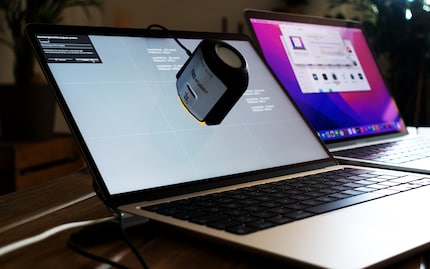
As you can see in the picture, I take measurements in nine areas of the panel. Here are the result of the M2 display:
| 379 nits | 396 nits | 375 nits |
|---|---|---|
| 396 nits | 410 nits | 387 nits |
| 359 nts | 387 nits | 367 nits |
The M2 notebook has a peak brightness of 480 nits. I calculated a relatively crisp, static black and white contrast of 1337:1. It may be twenty nits less than promised, but the naked eye can hardly notice that value.
However, it’s a different story with uniformity of illumination. If I look at a white surface on the screen, I get the feeling there are some minor differences. The upper area is slightly less illuminated, as the measurements also show. The biggest difference in brightness is 60 nits – from the middle to the left upper corner. That difference amounts to 11.7%. But that’s complaining at the highest level – at least, it is when you’re talking about an entry-level notebook like this. Certainly, when working and watching films, I don’t notice the difference.
What impedes me more is the fact the display doesn’t have HDR support. But I wasn’t really expecting that.
It goes without saying that I measured the same things on the MacBook Air M1. Here are the results:
| 455 nits | 460 nits | 464 nits |
|---|---|---|
| 476 nits | 515 nits | 505 nits |
| 466 nits | 495 nits | 485 nits |
The M1 notebook provides 384 nits peak brightness and has a static contrast of 887:1. In terms of uniformity, the maximum deviation is 12.4%. The brightness is good so far, but the contrast value is far below it. And that’s something you can already see in the direct comparison of the panels. As for images and films, they have a little more depth on the M2 display.
Magic keyboard and trackpad: the latter is less magical
I can reach the top row on the M2 keyboard that’s been adapted in size to the other keys just as well as I can reach the shortened key series on the M1. Nevertheless, it feels like there’s more precision on the M2 and I can activate the fingerprint sensor better. Besides that, typing on the keys feels softer right from the first one I press. And the haptic feedback that gets triggered at the start of the key path feels less «mechanical». The key stroke is estimated to be just over a millimetre.
I soon get used to the keys and find that, even though the keyboard isn’t any more magical than that of other notebooks, it still does the job reliably and quietly.
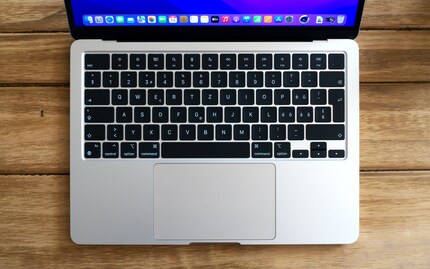
What’s less magical is the trackpad. It’s no different to its predecessor, save for the small adjustment in the dimensions. While it’s nice and big, it also has a small weakness shared by many touchpads from other manufacturers. If, like me, you often have slightly sweaty fingertips in the summer, the trackpad doesn’t let you slide properly across with them. Sticky fingers are even worse, but that’s more of a personal problem.
It’s annoying, and it means I often don’t reach my cursor target as fast as I normally would. I only know of one manufacturer who has a solution to this that actually works perfectly. Microsoft’s Surface products have touchpads that offer less space, but have a surface that lets even damp and sticky fingers side with ease. With a single swipe, you’re there. The current Lenovo notebooks also boast good trackpads – just not as good as Microsoft’s.
Speaker: a step backwards
I know from the Surface Laptop 4 that invisible speakers built into the base can sound good. Apple has included four in the M2 laptop.
I put the M1 and M2 next to each other and stream various genres in lossless hi-fi quality via Tidal. After a few minutes, I’m sure the M1 sounds a little better than a Surface Laptop 4 and the M2 a bit worse. When I stream Soundgarden’s «Black Hole Sun», for instance, it becomes clear that the MacBook Air M1 swallows less bass and, by notebook standards, it comes across in a nice, balanced way. Meanwhile, the mids on the M2 seem somewhat washed out and restrained, which is why the clean trebles push themselves into the foreground.
That being said, even the speakers of the M2 needn’t hide away. If I take into account the masses of poor notebook speakers on the market, those on the M2 are undoubtedly among the better ones.
Battery performance for continuous video streaming
Continuous video streaming and also most office work tasks show that the M1 and M2 chips have efficient cores. Four of these ensure that the battery capacity is spared with a reduced workload. Meanwhile, four other performance cores are primarily there to provide a lot of power when it’s needed.
For the sake of comparability, I set the peak brightness of the panels to about 400 nits. That’s the third-highest level for the M2 and the highest for the M1. Before starting the test, I open the settings to make sure the brightness isn’t automatically adjusted by the sensor and that the display never falls into sleep mode. Incidentally, I can find my way around macOS settings just as well as those of Windows 11. Then I stream «Stranger Things» on Netflix and see how long it takes for the battery to run out and the notebooks to shut down themselves.
The MacBook Air M2 runs out of juice after 6 hours and 42 minutes. Given the bright image, that’s a decent performance. After that, it takes another few hours before the M1 test device follows suit and also runs out of charge. In amazement, I make a note of the run time, a whopping 9 hours and 18 minutes.
The notebooks have a battery that’s roughly the same size. For the M2, it holds 52.6 Wh, while the M1 contains 49.9 Wh. One thing that contributes to the fact the M1 still contains 2 hours and 36 minutes more in it is is the 0.3-inch smaller panel size. But I doubt it just comes down to that. As I’m not in the habit of carrying a crystal ball with me, I’ll refrain from speculation on what the exact cause is. The good news is that, when it comes to using the laptop in the office, I don’t notice any difference between the two devices.
Battery power and working in a mobile office
Apart from Photoshop work, I’ve used the MacBook Air M2 for absolutely everything for the past two weeks. The Photoshop thing is because I prefer to edit photos on a large screen. Although I could connect mine to the MacBook, I struggled to get the right adapter in time. When I switch to Windows briefly, I give my photos the finishing touch and notice that it somehow doesn’t matter what kind of OS I’m using. All the same, I must admit that macOS still isn’t my friend. Two weeks aren’t long enough to get everything automated and find replacements for all the programmes that aren’t available for macOS or that don’t have an updated version.
But if we’re talking about purely for the office, I’m completely satisfied with the app offer. At first, things like the missing delete button irritated me, or the fact that windows close with one click on the top left instead of right, or that I also have to press the Control key for a right-click or secondary click. What I find just as irritating from a Windows user’s point of view is that the click by tap only works once you’ve activated it. On the other hand, I welcome the fact that I can set up an offline account on the MacBook without using any tricks. This is where Microsoft kinda finds itself in the Stone Age. Conversely, when it comes to marketing their own services, Apple and Microsoft are on a par. Long live Safari and Edge.
Apart from the fact that I have to automate some things, using the MacBook Air in the office is a pleasant experience. The picture is bright enough, I can have a lot of browser windows open without anything faltering, my fingers flow across the keyboard, and on top of that, it’s a well-made, beautiful device. The battery will see you through one and a half working days before running out of juice, assuming you don’t have excessive video calls.
Apple M2: how much better is the new chip?
To find out how much better the new M2 chip is, I run two benchmark tests.
Maxon’s CPU benchmark Cinebench tests how well a processor performs when rendering 3D models. In the latest version R23, results are no longer determined on the basis of a single pass by default, but on the basis of work performed within ten minutes. An improvement, as it makes poor cooling concepts perform more realistically.
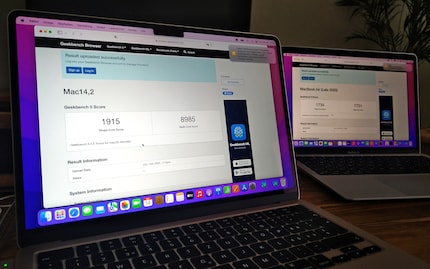
I ran Geekbench 5 as the second benchmark. Based on simulated, real-life scenarios, the CPU is tested for single-core and multi-core operation. You can also use it to test graphics performance. Testing only takes a short time and can therefore lead to good results even with poorly cooled devices. The benchmark runs on Windows, MacOS, Linux, Android and iOS. This also makes cross-comparisons between different processor architectures possible, which should be taken with a grain of salt. In x86-based processors, only one thread and thus not the entire (performance) core is utilised in single-core mode. ARM systems, on the other hand, use an entire core and thus have an advantage. It’s just another point to keep in mind when comparing results in Geekbench Browser.
Here are the test results for both of the MacBook Airs:
The new processor runs using 3.2 gigahertz for multi-core tasks and 3.5 gigahertz for single core. Compared to 3.0 and 3.2 gigahertz in the M1. In multi-core processor tests, the M2 achieves 15.6% more performance in Cinebench and even 15.9% more in Geekbench compared to the M1. Single Core is 5.8% and 10.4% higher. According to Geekbench, the graphics performance increased by 35.2% in OpenCL and by 34.3% in Metal.
Here’s another small comparison: with a mobile high-end 12th gen processor from Intel, an actively cooled Core i7-1260P with twelve cores, Windows has 10,094 points for multi core and 1,651 points for single core on Cinebench R23. Whereas, with the entry-level Microsoft notebook Surface Laptop Go 2, which boasts a slightly less potent, 11th gen Intel Core i5, there are only 3,450 points for multi core and 1,313 points for single core. But even this score is by far sufficient for what you’d need in the office.
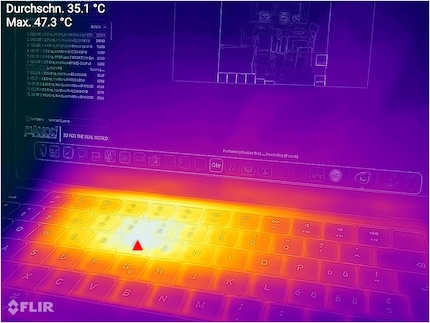
Since housing can get hot under continuous use, I present last but not least a thermal image of my FLIR cam of the Cat S62 Pro. It shows that the M2 case reached up to 47.3 degrees Celsius during testing. For the M1 case, it was 45.3 degrees Celsius at the same point. That’s not much either – with Intel notebooks, I’ve been known to record over 60 degrees Celsius.
Verdict: good, but some of the magic is lost
Apple has given the MacBook Air a good upgrade. The benefits of this aren’t solely down to the M2 chip. So as a sceptic who had to work with it, it wasn’t as painful as I feared. And I have to admit that I’m envious of the fact the device itself is great. I like that the screen has become brighter and more contrasting compared to the M1 predecessor. In terms of design, there’s nothing to complain about and the quality and finish are impeccable. Despite passive cooling, there’s no lack of power – especially if you primarily use the device for office work, surfing the net and watching films. However, if you regularly edit 4K videos, you should consider using a stronger MacBook without the Air addition and active cooling. That or you reach for a cough rival Windows product.
What could be improved is the trackpad. The reason being it’s harder to operate with sweaty fingers than it is with the Microsoft competitor or Lenovo. Equally in need of improvement is the uniformity of the display illumination. The biggest waste there is 60 nits and 11.7% respectively. When it comes to the new speakers, I’m still torn. They sound audibly worse than those on the M1, and yet they’re still good for notebook speakers. They’re definitely going in the right direction with the fact that you can’t see any visible speaker opening.
All in all, the new MacBook Air is a good laptop that I can recommend if you’re willing to spend around a third more than you would for the previous model just to get the innovations. It has its rough edges and not everything is perfect, magic or amazing. What’s more, the battery life has decreased on the M2 compared to the M1 when streaming Netflix. Nonetheless, the 2022 version of the Air is certainly the best entry-level MacBook experience you can get your hands on. Just as my first Apple review is my best to date.
I find my muse in everything. When I don’t, I draw inspiration from daydreaming. After all, if you dream, you don’t sleep through life.
These articles might also interest you
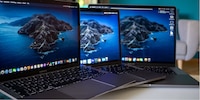
Product test
MacBook Air vs. Pro 13 vs. Pro 16: The big comparison
by Kevin Hofer

Product test
Microsoft Surface Laptop Studio 2 tested: seductive, expensive, with room for improvement
by Martin Jud

Product test
Testing the Microsoft Surface Laptop Go 2 – a better display and more powerful than ever
by Martin Jud
